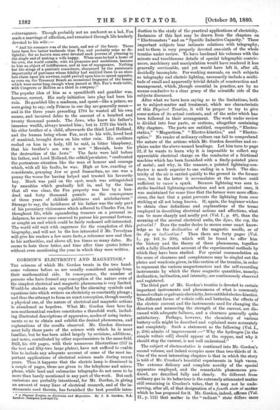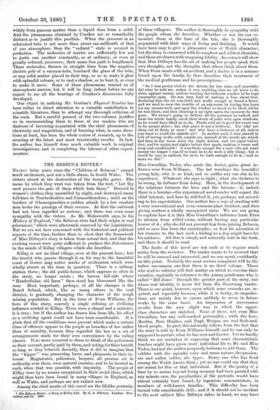GORDON'S ELECTRICITY AND MAGNETISM.* TIIE sciences of which Mr. Gordon
treats in the two hand- some volumes before us are usually considered mainly from their mathematical side. In consequence, the number of persons who have formed any conception of the nature even of the simplest electrical and magnetic phenomena is very limited. Would-be students are repelled by the alarming symbols and equations into which writers on electricity so constantly plunge ; and thus the attempt to form an exact conception, though merely a physical one, of the nature of electrical and magnetic actions is abandoned as hopeless. What Mr. Gordon does here for non-mathematical readers constitutes a threefold work, includ- ing illustrated descriptions of apparatus, modes of using instru- ments so as to obtain and exhibit the desired phenomena, and explanations of the results observed. Mr. Gordon discusses most fully those parts of the science with which he is most familiar, but he has been aided largely by revisions, additions, and notes, contributed by other experimenters in the same field. Still, his 600 pages, with their numerous illustrations (257 in the text and fifty-two large plates), have not sufficed to enable him to include any adequate account of some of the most im- portant applications of electrical science made during recent years. Thus it happens that the electric lamp is dismissed in a couple of pages, three are given to the telephone and micro- phone, while laird and submarine telegraphs do not seem to be more than barely mentioned in any part of the work. But such omissions are probably intentional, for Mr. Gordon, in giving an account of many lines of electrical research, and of the in- struments used therein, has furnished the best possible intro- • A Physical Treatise on Electricity and Magnetism. By J. E. Gordon, BA. London ; Sampson Low and Co.
auction to the study of the practical applications of electricity. Instances of this fact may be drawn from the chapters on " Electrometers " and on "Specific Inductive Capacity." These important subjects bear intimate relations with telegraphy, and to them is very properly devoted one-sixth of the whole treatise under review. To have burdened his volumes with the minute and troublesome details of special telegraphic contriv- ances, machinery and manipulation would have rendered it less generally serviceable, and yet would have left it, after all, decidedly incomplete. For working manuals, on such subjects as telegraphy and electric lighting, necessarily include a multi- tude of small and apparently trivial details of construction and management, which, ',though essential in practice, are by no means conducive to a clear grasp of the scientific side of the subjects discussed.
After what we have been saying as to the limitations, both as to subject-matter and treatment, which are characteristic of this Physical Treatise, it will be proper to try to give some notion of its actual contents, and of the order which has been followed in their arrangement. The work under review is divided into four parts, or sections, altogether containing fifty chapters. The parts are entitled, respectively, "Electro- statics," "Magnetism," " Electro-kinetics," and " Electro- optics." No reader of ordinary culture can fail to comprehend the nature of the actions which Mr. Gordon describes and ex- plains under the above-named headings. Let him turn to page 22, if he wants to learn why it is impossible to collect any appreciable electrical charge on the conductor of a frictional machine which has been furnished with a finely-pointed piece of metal ; and why, in like manner, a pointed lightning-con- doctor is much superior to one ending in a knob. The elec- tricity of the air is carried quietly to the ground in the former case, but in the latter it accumulates at the surface until sufficient to cause' a spark. Because lightning was seen to strike knobbed lightning-conductors and not pointed ones, it was maintained for some time that the former were more effica- cious, the fact that a point prevents the lightning from ever striking at all not being known. If, again, the beginner wishes to obtain clear definitions and explanations of the terms employed in describing electrical actions and affections, what can be more sharply and neatly put (Vol. I., p. 49), than the meaning of the several electrical units, the dyne, the erg, the potential ? Does the reader desire to secure some exact know- ledge as to the declination of the magnetic needle, or of its dip or inclination ? Then there are forty pages (Vol. I., pp. 161 to 200), which will be found to offer him the history and. the theory of these phenomena, together with a fully illustrated account of the experimental methods by which they have been studied. For special commendation on the score of clearness and completeness may be singled out the plates and woodcuts given, in this section of the treatise, in order to represent the various magnetometers and the self-recording instruments by which the three magnetic quantities, namely, declination, inclination, and intensity, are continuously observed and registered.
The third part of Mr. Gordon's treatise is devoted to certain important instruments and phenomena of what is commonly termed voltaic or galvanic electricity, here entitled electro-kinetics. The different forms of voltaic cells and batteries, the effects of the electric current and the instruments used for changing the direction and measuring the strength of the current, are dis- cussed with adequate fullness, and a clearness generally quite satisfactory. Perhaps, however, the chemistry of various battery-cells might be described and explained more accurately and completely. Such a statement as the following (Vol. I., p. 206) admits of improvement :—" Why the hydrogen [in the simple voltaic cell] should appear at the copper, and why it should stop the current, is not well understood."
The subject of electro-statics is continued into Mr. Gordon's second volume, and indeed occupies more than two-thirds of it. One of the most interesting chapters is that in which the story is told of Mr. Crookes's beautiful experiments in high vacua. The extreme delicacy and complete novelty of the special apparatus employed, and the remarkable phenomena pro- duced, are described fully and clearly. So different from ordinary gas in its behaviour is the extremely attenuated matter still remaining in Crookes's tubes, that it may not be unde- serving, after all, of that designation of a fourth state of matter which he has proposed for it. Mr. Gordon, indeed, affirms (Vol.
p. 112) that matter in the " radiant " state differs more
widely from.gaseous matter than a liquid does from a solid. And the phenomena obtained by Crookes axe so remarkably distinct as to justify this position. When the pressure in an exhausted tube is not more than about one-millionth of that of our atmosphere, then the " radiant " state is secured in perfection. The molecules of matter are sufficiently few not to jostle one another constantly, as at ordinary, or even at greatly reduced, pressures ; their mean free path is lengthened. These molecules, thrown in straight lines from the negative electric pole of a vacuum-tube, bombard the glass of the tube, or any solid matter placed in their way, so as to make it glow with splendid colours, or to cast a Shadow, or to heat it, or even to make it move. Some of these phenomena remind us of atmospheric anrorm, but it will be long indeed before we can expect to see all the bearings of Crookes's discoveries fully developed.
Our object in noticing Mr. Gordon's Physical Treatise has been rather to direct attention to a valuable contribution to scientific literature, than to attempt any thorough criticism of the work. But a careful perusal of the two volumes justifies us in recommending them to those of our readers who are desirous of becoming acquainted with the chief phenomena of electricity and magnetism, and of learning what, in some direc- tions at least, has been the whole course of research, up to the securing of the latest and most trustworthy results. In fact, the author has himself done much valuable work in original investigations, and in completing the labours of other experi- menters.







































 Previous page
Previous page